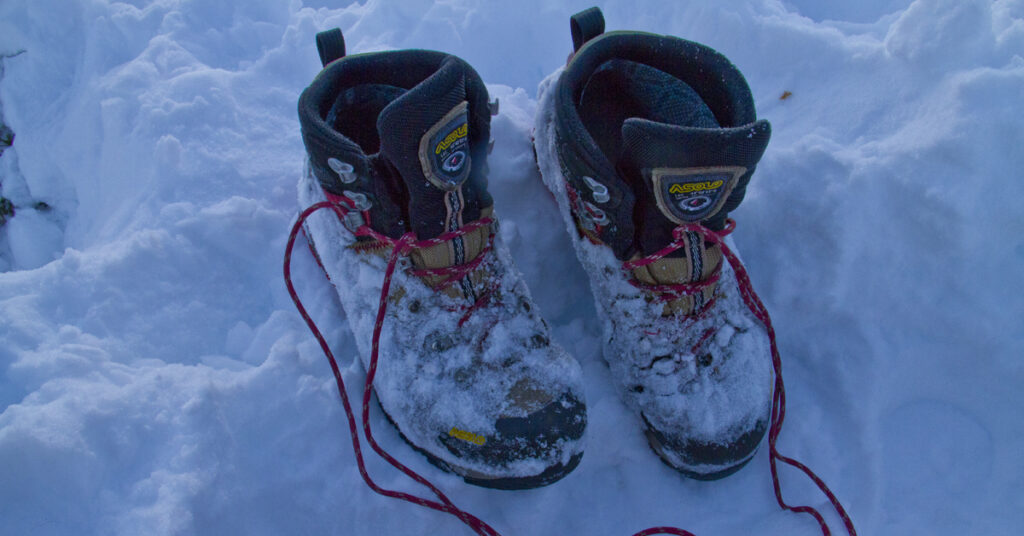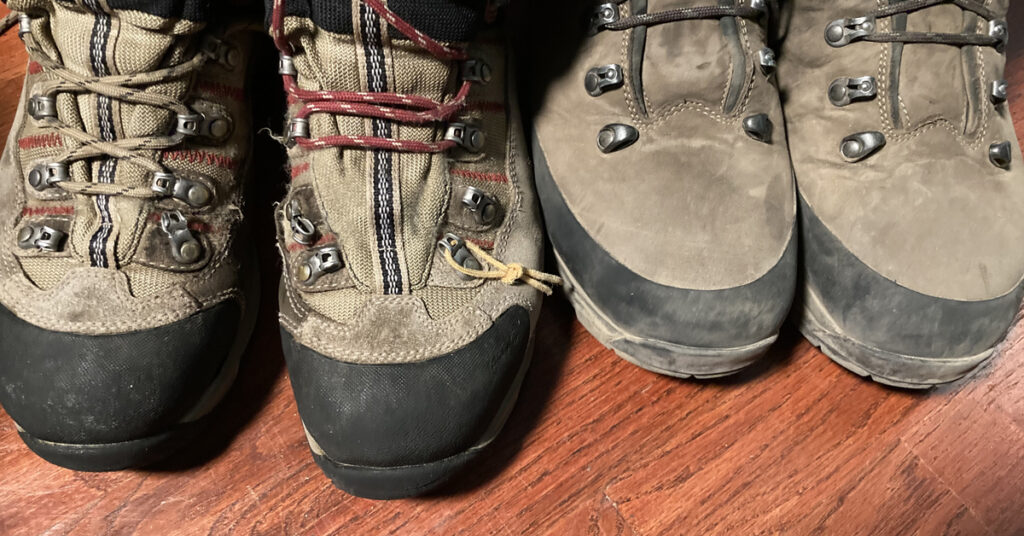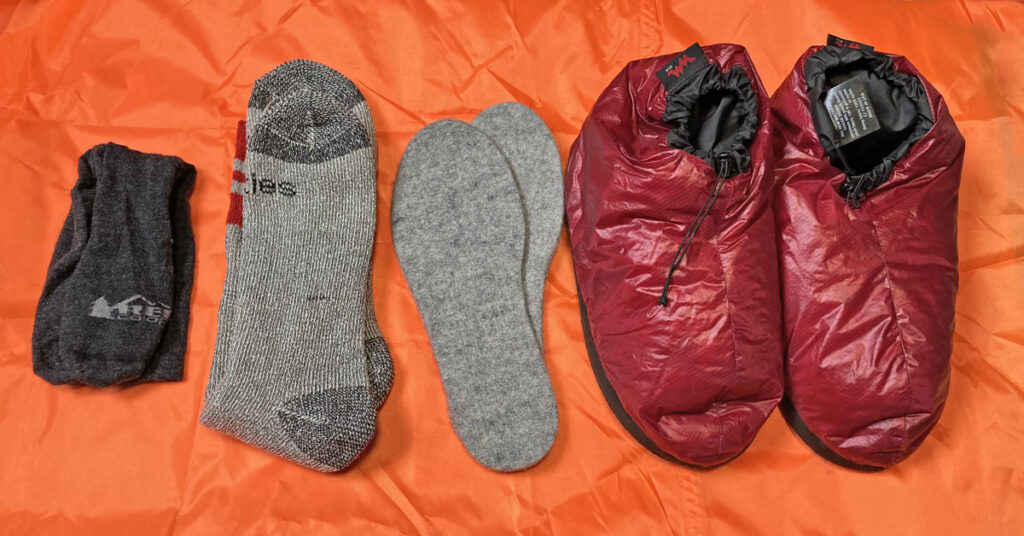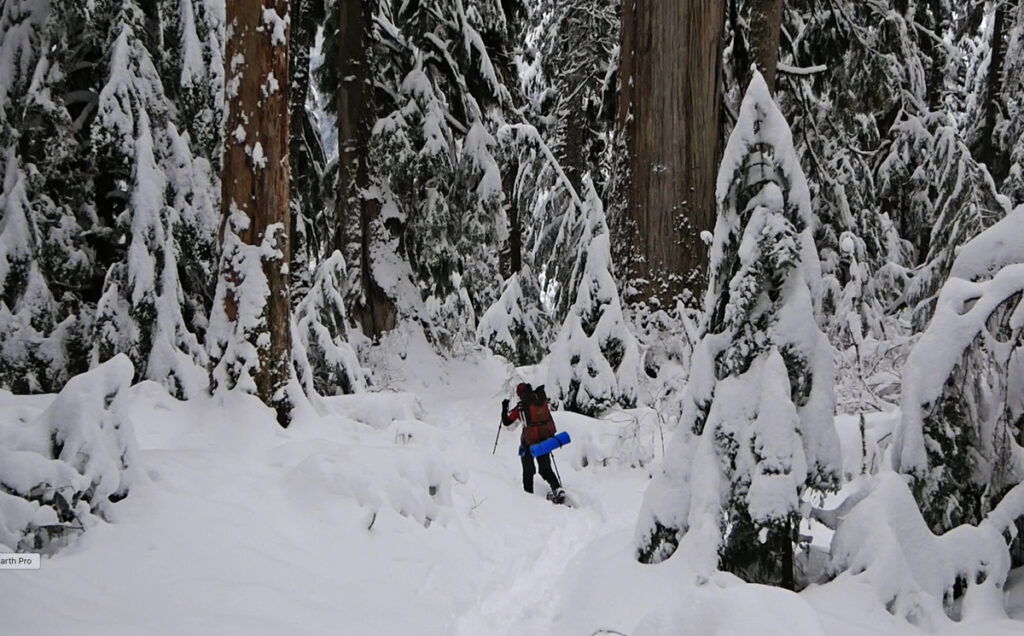Truth 1: Circulation equals warmth.
Make sure your boots fit correctly. Not too loose or too tight. If your boots are too tight-blood circulation will be reduced causing your feet to become cold, especially when you are not moving. Overly-tight boots often occur when hikers use their three-season hiking boots with thicker wool socks or layer socks with sock liners.

When you select hiking boots, the boots need to be slightly loose. Here are some tips for getting the right fitting winter boots:
- Wear the type of socks you will hike in when trying on new boots. To reduce blisters and add warmth, use a layered sock approach. Use a thin liner sock and a thick wool outer sock. If the boot is too tight with layered socks, try wider size boots or go up a size or both. For hiking, layering socks is a better method of adding warmth than using heavy boots with boot liners. Boot liners work better for mountain climbing when your feet are often stationary. When hiking, boot liners are too insulated causing the feet to get wet from sweat.
- Consider wearing boots that are a size larger. As you hike, your feet will expand, reducing circulation if the boot is too tight. Any reduced circulation will lead to cold feet. Try on boots with the laces undone. Shove your toes into the front of the boot, then place your index finger between the back of the boot and your heel. The index finger should just fit. When the boot is laced, the toes should not hit the front of the boot, which is important when hiking downhill. Lace the boots to prevent the heel from slipping.
- Lace the boots based on how they fit your feet. There are a number of ways to lace a boot for better comfort and circulation. If your boots are too tight, don’t cross the laces above the tight spots. You can also not use the eyelets closest to the toes and start the laces higher up to loosen the toe of a boot. If you use this method, you may need to attach a loose or elastic string at the first eyelets so you have something to latch your gaiters.
- If the heel is slipping, use two surgeon knots starting at the first eyelets below the first hooker eyelet (the eyelet closest to your heel). Another method, called the “heel lock,” involves going straight up from the hooker eyelet to the eyelets above then across and under the laces above the hooker eyelets (be sure to tighten by pulling toward your toes) and then completing the laces as normal. Also, if the boots are not fully broken in, preempt blisters by putting Moleskin on the back of your heels or any spot likely to get blistered.

Truth 2: Waterproof boots are not enough to keep your feet dry and warm.
Staying warm means staying dry. Melting snow is one cause, but ironically, another easiest way to get wet in the winter is from sweating.
Some brands or types of winter hiking boots are more waterproof than others. Ideally, boots should be both breathable and water-resistant. If the boots breathe too much, snow-melt will soak the boots. If the boots are too waterproof, such as covered in solid plastic materials, your boots will get soaked from sweat on hard hikes. There is no sure way to avoid both sweat and external moisture. Instead, you have to know how to manage the combination. Here are some tips:
- Waterproof, but not too waterproof: Wear water-resistant but breathable boots. Boots that use materials such as leather and Gore-Tex will need periodic waterproofing.
- Carry extra socks: If your boots get wet from water or sweat, fresh socks will not solve the problem. The fresh socks will quickly become soaked. Nevertheless, you will need dry socks for the time at the campsite and sleeping at night. Once the boots are wet it is highly unlikely they will ever dry out on cloudy winter days, so you will need to put your wet socks back on for the following day if you are on a multi-night trip. Do not attempt to dry boots with a stove or fire. The direct flame will instantly melt the synthetic materials.
- Consider vapor barrier socks: Super warm mountain climbing double boots, Mukluks, or Army Bunny Boots are not necessary or recommended for long-distance winter backpacking in the Pacific Northwest. For that reason, vapor barrier socks are unnecessary. However, if you are using boots that are too waterproof and getting wet from perspiration, vapor barrier socks will keep the boots dry. You can also use vapor barrier socks or plastic bags to keep your socks dry around camp when you need to use boots that are already wet from snow melt. (See A New Use for VP Socks.)
- Wear gaiters: Wear gaiters that extend above the calves. The point of the gaiters is to help protect your ankles from the crampon spikes on the opposite foot and to keep snow moister from getting inside your boots. When you are wearing micro-spikes or crampons and hiking on snow you will often posthole (sink down into the soft snow) allowing snow to enter the top of the boot. The snow accumulates and melts from your body heat, gradually soaking your boots. Gaiters help prevent this from happening. The gaiters also provide additional warmth to the legs and protection from wind. Even when wearing snowshoes (reducing post-holing), gaiters will help keep snow from melting on the top of your boots.
- Use booties at camp. When you arrive at camp after a long hike, your feet will be sweaty or moist. Take off your boots and air dry your feet as best as possible. You can sometimes use the upper portion of the socks to towel dry your feet. Then put on a fresh pair of dry socks—a thin smart wool liner and a thicker wool outer sock. Then put on insulated booties. You can also add wool insoles to the booties for extra warmth when your feet are on the snow. You can put wool insoles in your hiking boots too and switch them into your camp booties along with your booties insoles (i.e., two layers of insoles). Vapor barrier socks can be used as a type of ultra-lite camp booties.
- Always have dry wool socks for the night. Do not put on dry socks at camp and then put back into your wet boots. You will need dry socks to stay comfortable at night when you are sleeping. Having a complete fresh base layer—pants, shirt, and socks, also protects your sleeping bag from body grime. You can sleep with the dry socks on and wear them on the hike the following day if it is the last day. On multi-day trips, you can alternate socks, letting socks dry out during the day if conditions are sunny and warm enough. If the conditions are too wet or cloudy, put the wet socks back on whenever you are wearing the wet boots. Always have dry socks for nights and emergencies. Never wear cotton socks while hiking in winter.
- Don’t let your boots freeze at night: Be aware that once you remove your boots, the boots may quickly freeze solid, making them ice cold and very hard to get back on. If you place frozen boots in a drysack at the bottom of your sleeping bag hoping to thaw them out, you will be putting ice next to your feet. To avoid this, keep wearing your boots until you have boiled water to make a hot Nalgene bottle. Make sure the water bottle is tight and place it with your boots in your sleeping bag inside a waterproof bag. Clean the snow off the boots first. The hot water bottle will stay warm for many hours keeping both your feet warm at night and preventing your boots from freezing. Not all sleeping bags have room for this method. An alternative is to let your boots freeze at night and then put them in your sleeping bag in the morning with a hot water bottle. They will unfreeze while you are up doing other things such as making breakfast.
- Avoid standing around on the snow or ice. Don’t loose you heat. This is a very important principle. When you are at camp pull out your solid-core sleeping pad and put it under your feet to insulate yourself from the cold. Use it to sit on when cooking. It needs to be under any part of your body that would otherwise have contact with the snow. Once you lose heat, it is hard to get it back. So, don’t loose you heat!

Truth 3: Keep your core warm because that will help keep your feet warm.
If your core body temperature drops too low, your body will constrict blood vessels in your feet and hands in order to divert blood to warm your vital organs. That is, as a survival method, your body will sacrifice feet and hands to survive. This means that it is necessary to keep your core warm in order to keep your feet and hands warm.
Here are some factors that will cause your core to lose warmth:
- Water—sweat or moisture—draws warmth away from the body faster than air.
- Wind removes the warm air from the surface of the skin.
- Physical exhaustion can cause a reduction in heat-generating warmth.
- Medical conditions such as diabetes, an under-active thyroid, anorexia, severe arthritis, and traumas.
- Drugs or alcohol use expands blood vessels increasing heat loss from the surface of the skin.
The best way to keep your core warm is to layer your clothing and stay dry.
It is obvious that you should not wade through streams in the wintertime, but keeping boots dry cannot always be prevented. In the Pacific Northwest, staying dry is complicated by above freezing temperatures at lower elevations, often turning the snowpack into slush and turning falling snow into either rain or wet snow that sticks to the surface of your clothing and quickly melts.
No matter how hard you may try, preventing wet feet and soaked boots may be impossible in some conditions.
Because the trailhead is often at lower elevations, your boots will get wet at the start of the hike and you will later be at higher and colder elevations when you reach your campsite. This means it is essential to monitor the weather forecast for the possibility of above-freezing conditions and to bring extra clothing for the nighttime and emergencies. It also requires that you keep your extra clothing and sleeping bag in a waterproof stuff sacks while in your pack. A rain cover over your pack is not always sufficient waterproofing.
Key points to remember:
- When you stop hiking, pitch your tent and get inside out of the wind.
- Remove sweaty clothing and change into fresh dry clothing immediately before making food or doing other activities.
- Carry extra gloves and mittens. (See What are the Best Gloves for Winter Backpacking?)
- Always carry a rain jacket and rain pants to use for wind protection.
- Fresh thermal base-layer and rain pants are a good strategy around camp.
For more, see The Fifteen Essentials for Winter Backpacking
Now that you have learned the basics for how to keep your feet warm, pass them on to others by sharing this blog post.
Let me know if you have any questions or suggestions. I’ll be updating this post periodically, adding new tips, correcting bad grammar and spelling, etc.
Also, don’t forget to subscribe to my blog and leave comments below.
